In: Documentary
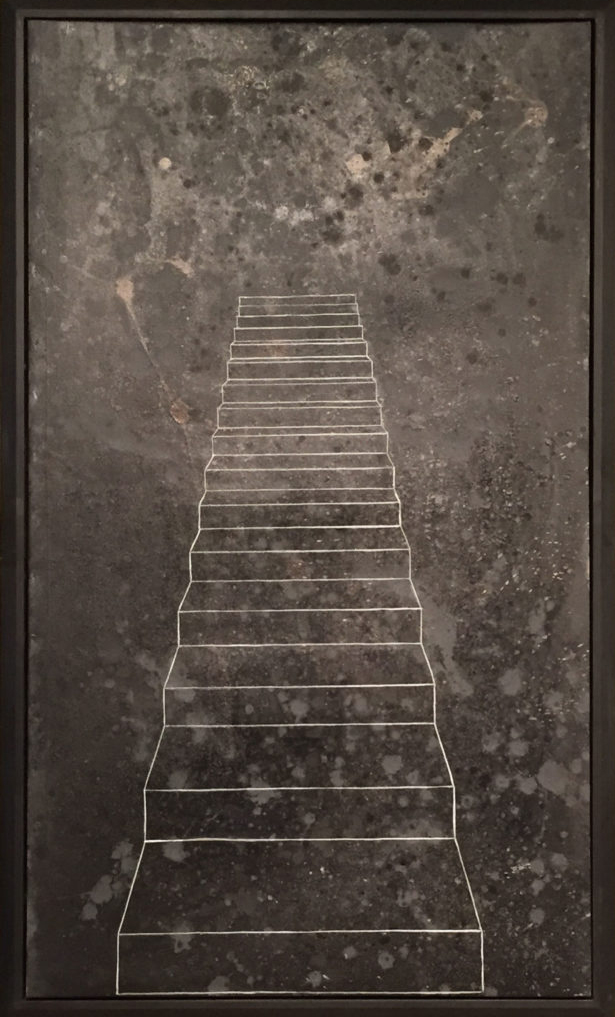
Ron Boaks | Stairway To The Heavens V | 2017
October 20, 2023Ron Boaks | Stairway To The Heavens V | 2017
There is a black which is old and a black which is fresh. Lustrous black and dull black, black in sunlight and black in shadow.
(Ad Reinhardt, from Art-as-art: The Selected Writings of Ad Reinhardt)
The dead cannot remember themselves; that’s why the living have to.
(Sarah Monette)
At the risk of getting too personal, too subjective, it’s often not a good experience to go to an art opening when you’re known in the community as an arts journalist. RM Vaughan has written about this, but there are – of course – exceptions to this rule, stepping outside the space where you have individuals attempting to bully and bleat or blow smoke up your ass, ahem.
When I was spending time in an exhibition of Ron Boaks’ painting a few years ago at a gallery in Niagara, an impromptu conversation with the artist became a high point of interaction and conversation about his work (and the larger milieu of artmaking, too).
At that time, Ron and I spoke about a body of work I colloquially refer to as the ‘Staircase’ series. These are (literally) darker works with an assortment of symbolic or metaphorical glyphs “scratched” and seemingly etched into and upon them : many of the pieces are defined by the recurring – but simple and perfect in execution – staircase. This offers an invitation to another site : not so much an ending as a transition to another place and sense of being.
Our conversation, at some point, touched upon how these were scenes Ron had created in response to the loss of loved ones : and I should clarify that they were dark in a formal sense but not in an experiential one. They had an element of hope, an injection of transcendence, perhaps, instead of a commentary on endings.
This painting that I’m featuring is from that exhibition and grouping of artworks : Boak’s Spirit Arise series.
Boaks’ words : “With this body of work, I am trying to capture “the lightness of being”, that essence of life, state of grace, of being alive right now. In 2013 two very dear people to me died. Awhile after their passing, I began to feel lighter in “spirit”, as, if they were now free, that it was OK for me to feel that too. This lightness is translated into these paintings as the energy or spirit entity, surrounded by rich colour. The paintings are grounded by the almost drafted line, measured, as it were, like distance markers on a map. X and Y coordinates are usually there, doubling as chromosomes. There are collaged bits, often as the pieces on each side edge that mark my boundaries. Balance and the interplay of opposites is as important as ever. Some of these paintings are serene and sublime while others are happy in their intensity or darkness. These are complex relationships made visible as simply as possible. These works need to be mulled over, absorbed and enjoyed.”
I would later visit Ron’s studio and we chatted about his work : I always love when artists trust me enough to invite me into their spaces, and I think that initial conversation had a role in that.
This is an image that offers a sense of what comes after death (and I say this as someone who is between an agnostic and an atheist, most days): but that which we leave behind us exists in a variety of forms, whether our experiences with others or the impressions we leave upon them, that inspire those whom remain to commemorate our passing.
Ronald Boaks’ career as an artist spans 30 + years. He has exhibited throughout Canada, the United States and the United Kingdom. His artwork has been widely collected and can be found in many public, corporate and private collections nationally and internationally.
More about his work can be seen here (Boaks was a previously featured Artist You Need To Know from AIH Studios’ continuing series) and at his site.
~ Bart Gazzola
Read More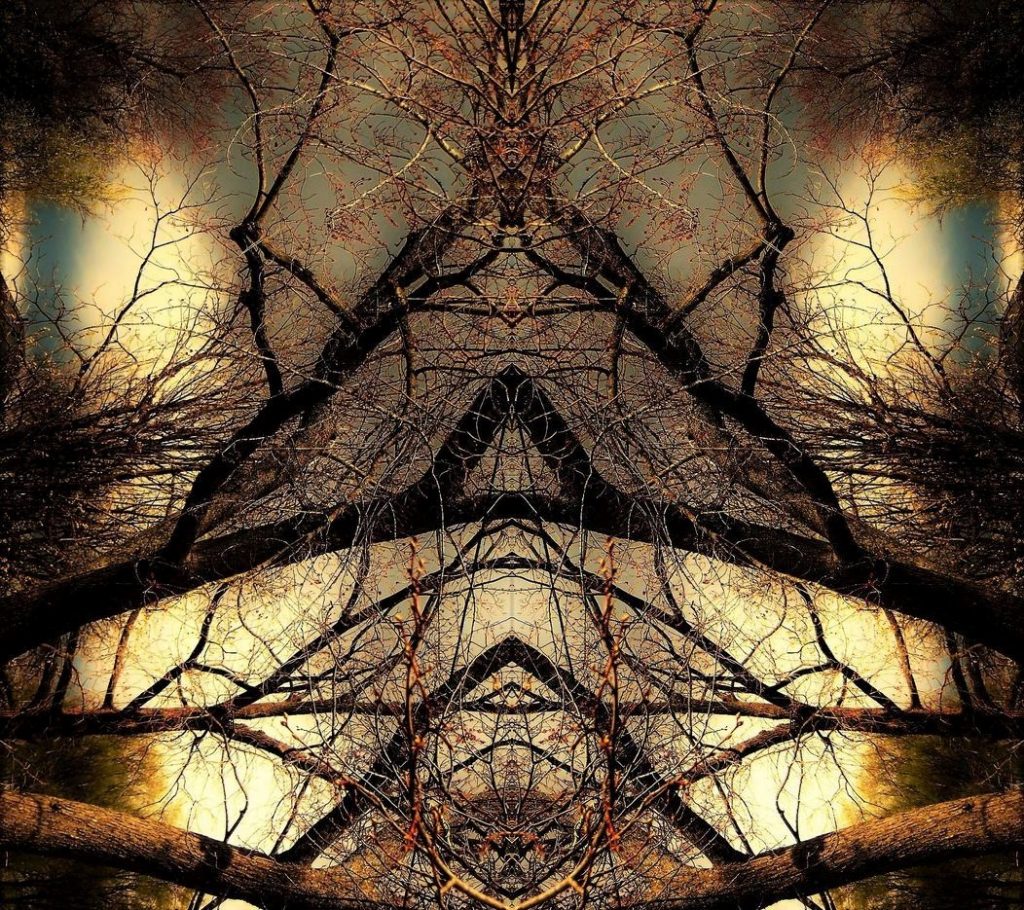
Diane Beard | Walking from the Darkness to the Light
October 2, 2023Diane Beard | Walking from the Darkness to the Light
“…life is brief and lovely, not long and foolish, that it is strange and beautiful, yeah as a dream, then so let it be, if it must be tears, if tears alone may serve…”
(Jack Kerouac)
Diane Beard is a photographer who takes pictures of her immediate community of Welland (usually while walking the streets of the city), often manipulating the images digitally to have a surreal or abstracted quality.
She was one of the featured artists in the Welland Creatives Network’ 13 on the 13th exhibition at the Welland Historical Museum in 2022. We became acquainted during COVID, when the artists’ group I facilitate – the 5 x 2 Visual Conversations – began to ‘meet’ online, and Beard was an enthusiastic and impressive participant.
Diane is the widow of artist Ross Beard (1953 – 2019) who was arguably the most significant visual artist in the history of the city of Welland. Frankly, I prefer to say ‘is’ as a recent exhibition of his work indicated that he lives on in his artwork and the joy many find within it.
His passing was – is – a fracture in her life, and part of her response has been the many images she’s produced and shared, both online and in the Niagara visual arts community.
From a recent exhibition – which was titled Walking from the Darkness to the Light – in St. Catharines : “Having been surrounded by Ross’s awe-inspiring art, sharing the same love of nature and appreciation for the Niagara area, driven by grief combined with a loss of identity after Ross’s passing, yet with no formal training, Diane began taking photographs as means to express her feelings and emotions. Diane’s sense of color and form transcends a simple mundane scene into something abstract and at times unrecognizable mimicking the profound change in her life.”
I’ve been lucky enough to talk with Diane often about her work. The contrast between a scene you recognize and something completely alien is one of the aspects of her work that’s alluring. Beard has an innate sense of colour, composition and a vibrancy in her scenes. This vivacity is an appropriate challenge to the fact that these images are, at their genesis, about loss and mourning and how to move through that….
Beard shares images regularly on social media, and is a prolific artist. I’ve only shared a small part of her body of work, and more can be enjoyed here and here.
~ Bart Gazzola
Read More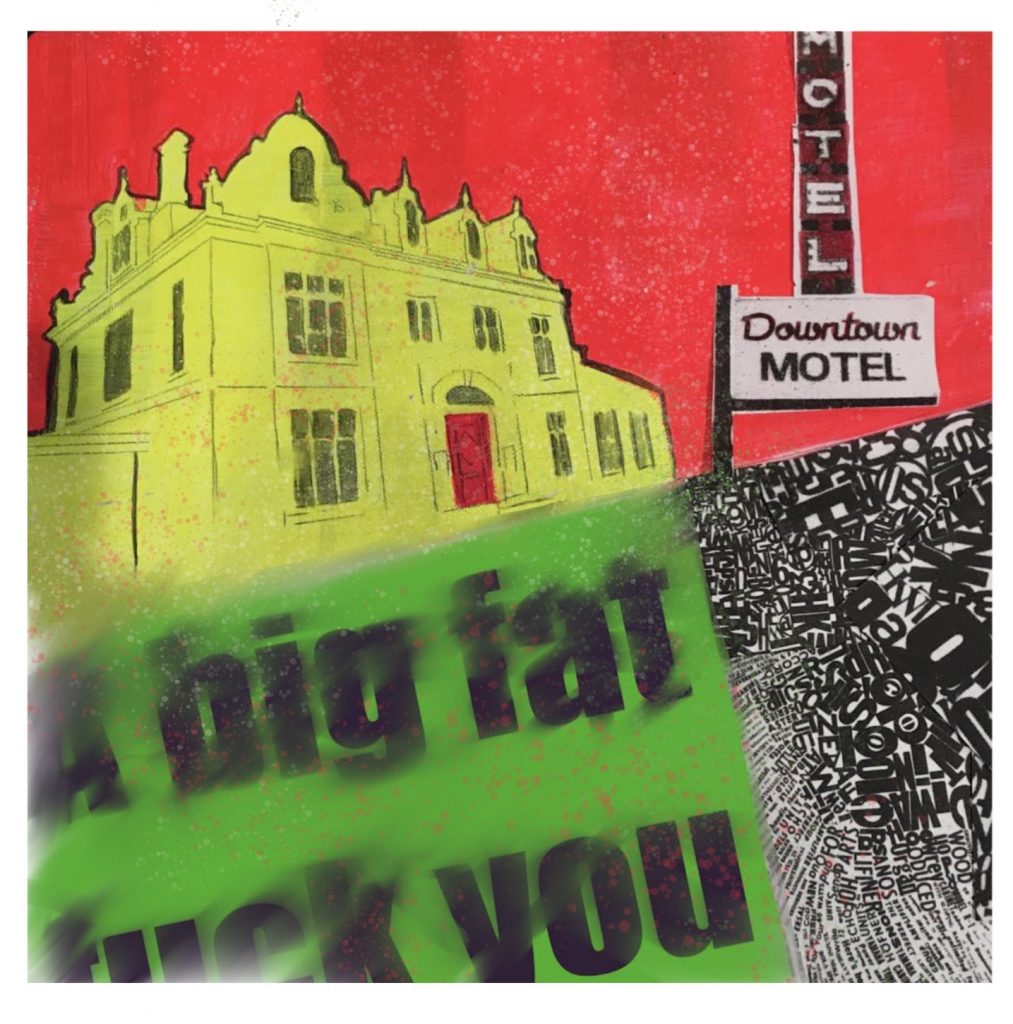
Liz Hayden | I dare you | 2022
September 24, 2023Liz Hayden | I dare you | 2022
“…the City’s refusal to support a public art gallery makes it’s endorsement of a heritage award a travesty.”
(Elizabeth Chitty)
A decade or so ago, I curated an exhibition from the archives of the now defunct (having merged into paved arts) Photographers Gallery in Saskatoon. On the accompanying panel (with artists Patrick Close, Sandra Semchuck and Doug Townsend, whom all had played seminal roles with the gallery as well as organizations like CARFAC and the Saskatchewan Arts Board) I made the observation that communities will create images of themselves that more accurately reflect the reality of the place, often when confronted with depictions that are not just disconnected from lived experience but in direct opposition to reality.
Liz Hayden’s image has been in my mind since she first shared it on social media some time ago : Hayden has been a vocal ally during the travails here in calling out the lies and self aggrandizing ignorance that has defined Brock University’s ‘demolition through neglect’ (to quote a past Cultural Coordinator for the city of St. Catharines) and sale of Rodman Hall Arts Centre, and the City of St. Catharines’ weathervaning between apathy and self congratulatory dishonesty.
The latest chapter in the travesty that is the City of St. Catharines’ apathy and ignorance – which has, in that manner I should know better by now, become even more egregiously foolish – was brought to my attention earlier this week. You can read more about that here. Essentially, the city council of St. Catharines – which I sometimes less than affectionately refer to as ‘North Welland’, to remind them that the delusion that STC is the ‘jewel’ of Niagara is a transparent lie to many of us in the cultural milieu – is seeking provincial heritage designation for the former gallery site, though it’s nothing more than a boutique hotel now, and all the things that made it an important site are now lost…
This is nothing more than STC Council giving an award to someone who has helped the local political cowards, miscreants, liars and ignorant incompetents NOT have to deal with the fact that the gallery may have been bulldozed and the subsequent critiques that would then expose their absence on the loss of the gallery and the harm this caused to the cultural community.
We used to have a nationally recognized and lauded art gallery, a centre for cultural and community oriented groups and now it’s just a ’boutique hotel’ and this merits recognition? This is an affront, especially considering the lackadaisical disinterest of the previous mayor and the inaction of many supposed ‘stakeholders.’
Did I mention that the city of St. Catharines has made some rumblings about wanting to have a ‘cultural renaissance’ in the city? Some things I cannot make up.
But now that I have set the stage with that intersecting rant, let us consider Liz Hayden’s artwork that speaks to these ideas. When we were speaking about it recently, she made the comment of ‘angry colours, wasted words.’
This work by Liz Hayden is titled I dare you : and I suspect that is a title that dares the viewer, but also those whom might be ‘offended’ by what the work states, to attempt to defend what has been allowed to happen, so their ignorance might be exposed. This is – like much of my writing and advocacy on the subject – perhps tilting at windmills : a recent ‘conversation’ on the Niagara History social media page was rife with people ‘excited’ at the new hotel, ignoring that access to the grounds would be limited, that a community focal point was gone, that citizens were irrelevant next to a few consumers and that this is a superficial facade that is a shoddy cover for what was an award winning artistic space that was deeply important to many.
These are some of the words that Hayden included to accompany another work in this series (which can be seen in the full post), but they are relevant here, as well :
Show me your garden and I shall tell you what you are. (Alfred Austin)
He is the gardener.
There at daybreak, he tills and waters: nurturing the plants, the community. Open-handed, he shares hard-gained knowledge and his harvest. Here is a place to heal, to grow. Free, in the air, without fear.
He is the gardener.
He walks the park, picking up.
Greets the old ladies, and their dogs, by name
A smile, the weather.
The garden is his purpose.
He toils there and grows
Himself and all of us
In that earth
This is one of a series of garden portraits I completed in 2022 focusing on gardens and gardeners here in St. Catharines, the Garden City. This acrylic on canvas portrays Richard Pierpont park, (previously known as Centennial Gardens) and Ross Hayden who has gardened there since the inception of those public gardens approximately 10 years ago.
A garden is a fine metaphor for a community : and there are many who are as insulted by the council’s proposal in terms of the loss of the green space as much as the artistic space. I will admit that I am also reminded of Oscar Wilde’s story about The Selfish Giant, but that one, at least, has a happy ending : but the giant had some introspection and that cannot be said for St. Catharine’s political ‘leaders’, on this front….
~ Bart Gazzola
Read More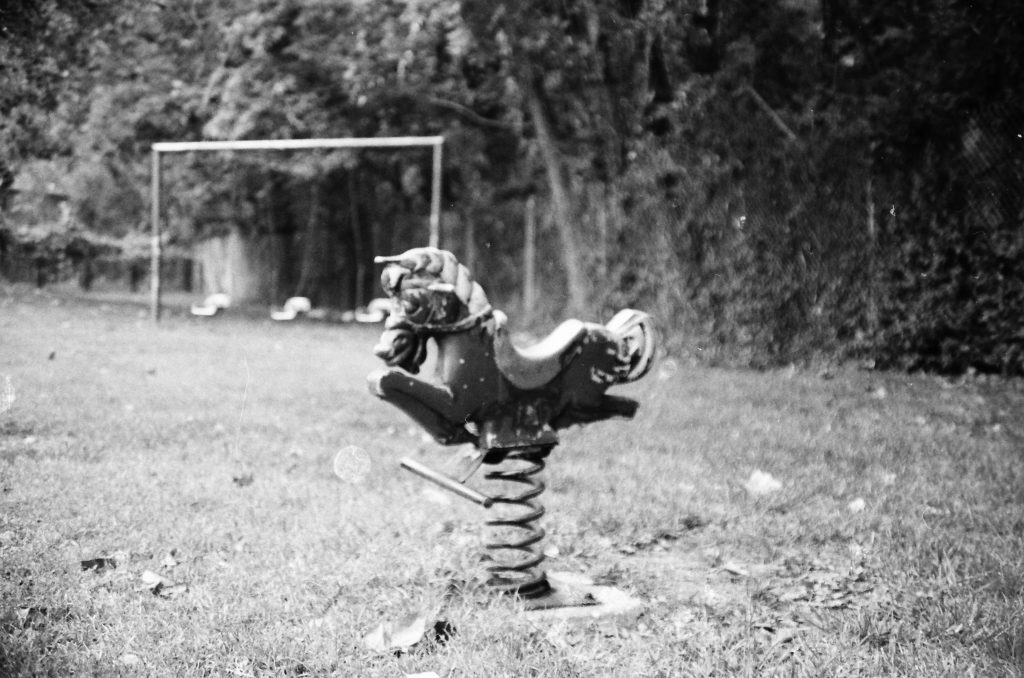
Chris Alic | Transience & Memory
September 16, 2023Chris Alic | Transience & Memory
One need not be a Chamber – to be Haunted –
One need not be a House –
The Brain has Corridors – surpassing
Material Place –
(Emily Dickinson)
The history of one who came too late
To the rooms of broken babies and their toys
Is all they talk about around here
And rebuke, did you think you’d be left out?
(Peter Straub, from Houses without Doors)
Like Mark Walton – and it’s a defining tenet of curated, I think – I also have a strong presence in my immediate and local visual arts community, with mine being Niagara : several of the artists I’ve featured here (Juliana D’Intino, for example, or Sandy Fairbairn) are ones that I’ve been lucky enough to include in a continuing curatorial project in downtown St. Catharines that began in Fall of 2022 and that is continuing indefinitely, with artists slated into late 2024.
Chris Alic is one of those artists, as her exhibition with Amber Lee Williams is currently on view at Mahtay Café & Lounge. That grew out of a 5 x 2 Visual Conversations evening (a relaxed sharing of art and ideas that I’ve facilitated for over five years, in St. Catharines and Welland). Like any good curator, I offered support to the two artists but primarily stayed out of the way, with some appropriate gentle nagging.
From that immediacy, let’s indulge some of my subjectivity that sparked my interest to consider these two pieces by Alic.
As the artist said when she spoke about the work, these are images from time she spent in Missouri in the United States – and, of late, I’ve fallen down another rabbit hole that centres upon the idea of the aesthetic of the Southern Gothic, whether that be in terms of crime or horror, but usually (and I own this) on the darker side. In light of this, the abandoned and lonely toys of Alic’s images take on a more ominous tone. Further clarification : I’ve been eschewing the ‘standard’ Southern Gothic horror of New Orleans, in my reading and research, but instead have been looking at other sites in the American South – like Charleston, or Alic’s Missouri – as these oft ignored sites have an unexplored richness in their stories that is more diverse than you might think. I also mention this – not just as another subjective indulgence – but because many of the stories I’m encountering in this enjoyable research are defined – or deformed – by the history of those sites (the institutional racism flows into the occult or supernatural horrors of the stories. There’s a story by Alan Moore about a television show that is shot on an old abandoned plantation where the filming somehow invokes the ghosts of the enslaved, and the actors ‘become’ their characters, with new manifestations of hate and racism being merged with old…all horror, they say, comes out of reality….or perhaps even the superficially banal, like Alic’s empty playground and abandoned tricycle….)
The words of the artist :
Memory is a huge part of what makes us human. Every interaction, every step, sight, sound, touch, smell – all these things create memory. But they are fragile. They are guided by perception, they are malleable, layered, are influenced by who we become, and who we become is in part made up of what we remember. Our memories continue to create us, and we create our memories. And we lose them. They fade, disintegrate, become suspect. They are subject to context, transformation and decay, and temporality, just like the spaces we inhabit and the things we use. They become the liminal space between an event and a feeling. Does emotion exist without memory?
I have been using a camera to secure my memories since I was a single-digit kid. I don’t remember ever not having a camera, or access to a camera. It was a part of my childhood, and everyone around me took photos and 8mm film of everyday life. My immediate and extended family were avid documentarians. I am continuing that tradition, but somewhere along the way I made the decision to “crop” those memories – to capture only small portions of context, little bits of an event, inexplicable to anyone but myself because each image is connected to an important moment, an emotion, a piece of who I became because of it. And then I edit. Adjust. Refine. Sometimes intentionally erase, fade, and transform them.
These seven images were made during a two-year period living in Columbia, Missouri. All were taken on a Yashica FX-70 Super 2000 film camera. I learned to use a darkroom and print my own photos with this film, and two of the images were only recently developed using caffenol-c. I had forgotten that I had taken the photos, I had forgotten the existence of the places until I saw them again.
The two person exhibition CHRIS ALIC & AMBER LEE WILLIAMS | TRANSIENCE OF MEMORY is on display at Mahtay Café & Lounge in downtown St. Catharines for the month of September, 2023.
~ Bart Gazzola
Read More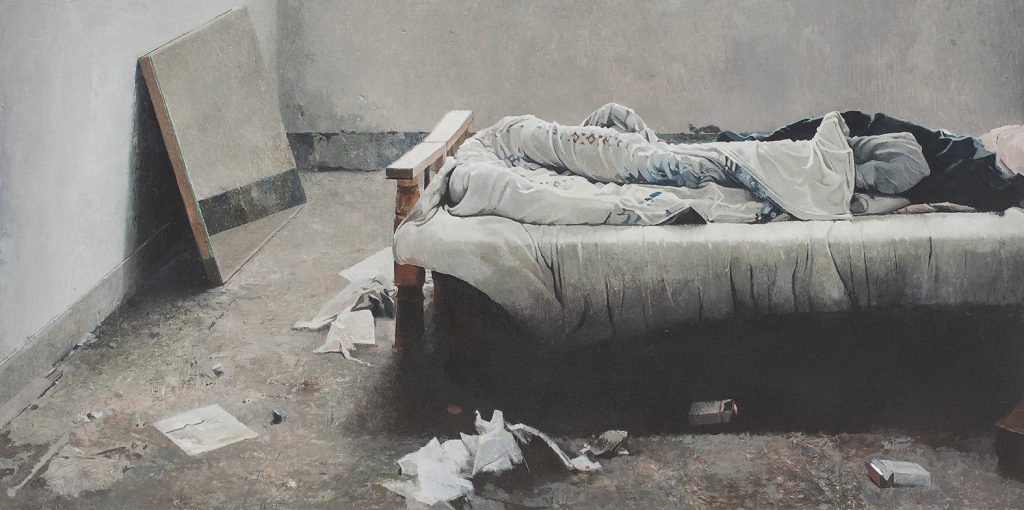
Joseba Sánchez Zabaleta | Room With Mirror
September 8, 2023Joseba Sánchez Zabaleta | Room With Mirror
“It is said that scattered through Despair’s domain are a multitude of tiny windows, hanging in the void. Each window looks out onto a different scene, being, in our world, a mirror. Sometimes you will look into a mirror and feel the eyes of Despair upon you, feel her hook catch and snag on your heart.
—————————————
In her world, there are so many windows. Each opening shows her an existence that’s fallen to her — some only for moments, some for lifetimes.”
(Neil Gaiman, from Season of Mists and Brief Lives, respectively)
Part of a larger series that engages with ‘footprints and memory’ and places now empty where the artist has recorded – or interpreted – the detritus of those who once existed in these spaces, Zabaleta’s paintings seem haunted. Though empty of people, their presences still suffuse the space, with an implication of absence, with someone missing that still is intrinsic to the atmosphere of his compositions.
His words : I wanted to paint the uninhabited buildings that I found in search of the memory of all those lives that I sensed should remain intact and detained in them. Waiting for something to happen, the empty buildings keep within their walls the trace of what has been lived between them. Somehow the fled love is imprinted on the plaster of its partitions. The silence of those deaf rooms falls through the walls, depositing itself between the joints in the pavement, next to the arid and dusty trace of time, among accumulated fragments, piled up by the wind in the corners.
One of the images I’ve shared in the full post is titled Marlom. Zabaleta offers the following meditation about this site, this painting, and the unknown person :
Of you there is only a name written in blue blood.
You thought it would be easy, that it would be just as they had told you. You thought that if others had achieved it, you would also achieve it. You thought while you were hiding, while the world was chasing you, what would be the best way not to be seen, to disappear, and you didn’t realize that nobody saw you, that you could have gone out on the road and walked, because those who are like you around here and you don’t look at them nor do you see them.
More of Joseba Sánchez Zabaleta’s fine paintings can be seen here.
~ Bart Gazzola
Read More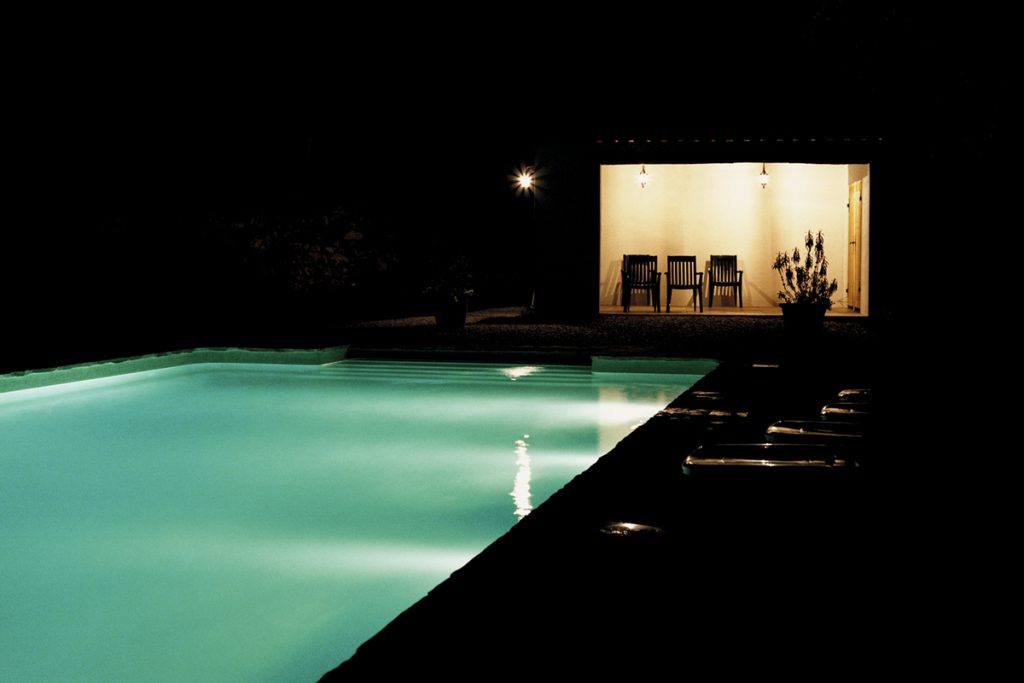
Alys Tomlinson | Dead Time | 2004 – 2006
June 23, 2023Alys Tomlinson | Dead Time | 2004 – 2006
“I like to remember things my own way.”
“What do you mean by that?”
“How I remember them. Not necessarily the way they happened.”
(from Lost Highway)
I’ve recently begun rewatching the third season of Twin Peaks (I mention this as Alys Tomlinson has spoken of Dead Time with allusions to the painter Edward Hopper but also that ephemeral notion of the Lynchian landscape): there’s a scene where Shawn Colvin’s version of Viva Las Vegas is a soft and enchanting soundtrack to the unfolding scene, and I happened to be listening to that song as I was perusing Tomlinson’s Dead Time series online. Vegas is, they say, a place where time is fluid, or can be lost or doesn’t exist in the same manner as elsewhere….
Tomlinson’s scenes are more Lynch’s Mulholland Drive or Lost Highway than Twin Peaks, with harsh artificial light casting edged shadows and revealing a sinister tableaux. Some critics have spoken of how time in the Lynchian universe – especially in Twin Peaks – is non linear, and Tomlinson’s images have an eerie familiarity (I’ve also travelled long distances by car and spent evenings in motels that, in recollection, blur together into one continuous banal experience).
There’s an element of the same unsettling darkness and emptiness that Steve Laurie employs in some of his images that also invite us to see them as film stills and create our own narratives for them. Tomlinson’s ‘America’ is empty, hard and bright. Swimming pools – usually sites of social interaction and enjoyment – are harbingers that seem more nefarious, here.
“For the past few years Alys has been photographing empty swimming pools at night in the UK and abroad. The images explore a twilight world of the in-between: a blurring of day and night, light and dark, the open and the enclosed, plenitude and absence. Whether municipal or members only, the pool is a space shaped by its patrons. Captured out of use, these familiar spaces stand outside time. Curved light breaks up the horizontal rigour. The comfort of transparency gives way to reflection and shadow. What is cedes to what could be, and the ordinary is transformed. The geographical location of each swimming pool is kept secret. Shot at dusk or at night, the pools take on a detached, almost melancholy, emptiness, and suggest a sinister feeling that something has happened, or is about to happen.” (from here)
Alys Tomlinson’s site can be seen here (she’s an award winning photographer and the diversity of her work speaks to her acumen with a lens, both formally and conceptually) and her IG is here. She has produced a book of these images, as well.
~ Bart Gazzola
Read More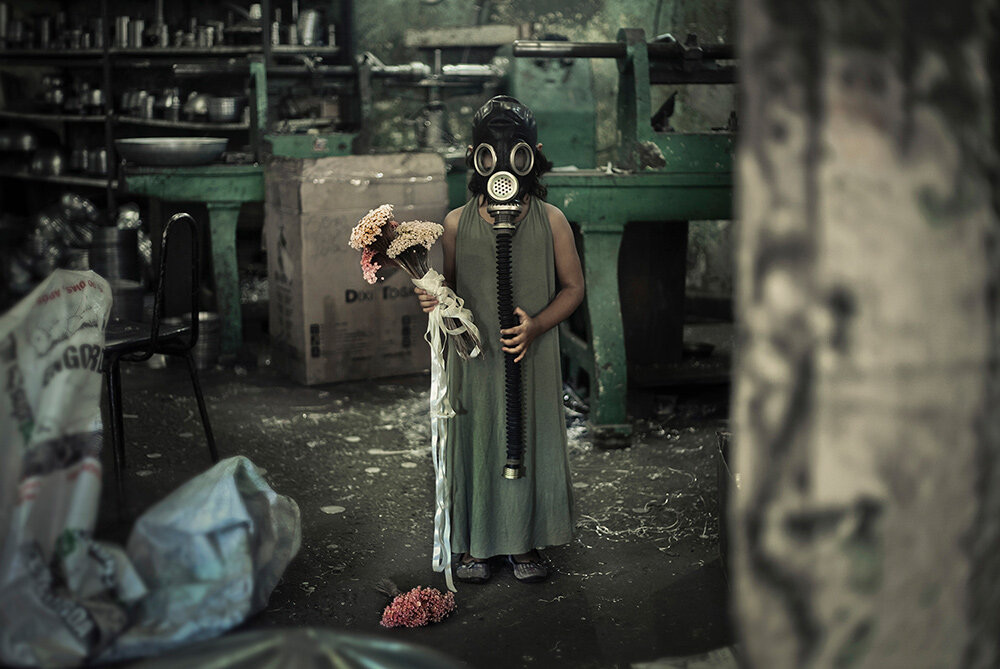
Hifa Cybe | Girl with the Gas Mask | 2020
June 3, 2023Hifa Cybe | Girl with the Gas Mask | 2020
I have heard the languages of apocalypse, and now I shall embrace the silence.
(Neil Gaiman)
Did you see the frightened ones?
Did you hear the falling bombs?
Did you ever wonder why we had to run for shelter when the promise of a brave new world unfurled beneath the clear blue sky?
(Goodbye Blue Sky, Pink Floyd)
I am convinced – though I’ve had difficulty tracking it down – that I read a line in Pasternak’s Doctor Zhivago, where one of the characters is talking of how, during the Russian civil war between the Whites and the Bolsheviks, it was a time when children only survived by eating the flesh of the dead (my memory of this line, even if invented, is quite visceral, and that intersects with some of Hifa Cybe’s work about memory – the veracity of it in personal narratives – too).
The quote I begin this piece with is – as some of you will know – from Pink Floyd’s The Wall, and this song always struck a chord regarding how in post WW II Britain a hoped for peace gave way to the Cold War, and that the idea – the fear – of an impending nuclear apocalypse – that we might bring about our own ending in a previously unimaginable manner – suffused a generation of children, as dour and suffocating and infecting as the bombs that ravaged people during WWII, and that do so still, now, perhaps forever….
I have little to actually say about Cybe’s artwork here : it’s power, simplicity in contradictions and the anxiety it induces are so intensely visual, so well executed, that my words would simply be a barrier to the viewer’s immediate engagement with it. An image like this also exposes the trite self aggrandizing act of Ai Weiei’s ‘reimagining’ of the image of drowned infant Alan Kurdi that in 2015 became the defining symbol of the plight of Syria’s refugees.
There is one thing to consider, though, in light of how Cybe’s research and artworks delve into trauma, especially in terms of memory and childhood. Here, in Niagara (as I make this post at the beginning of Pride month), we’re seeing the latest iteration of hatred against LBQT+ people, with a recent bilious spurt of it from a catholic school trustee : surely I’m not the only one who finds the rank stench of that hypocrisy, from a cult that has harmed so many – and so many children – too much? With this in mind, and looking at Cybe’s image, I am also reminded of friends I grew up with, in extremist religious environments, and that this scene might be a more exact psychological representation of their experiences, and tools of survival….
Luiza Jesus Prado, known as Hifa Cybe, is a transdisciplinary artist born in Guaratingueta, Brazil. She uses artistic tools such as photography, performance, video art, installation, sculpture, painting, new media, body art, music and drawing along with physics, psychology, neuroscience and philosophy. Cybe’s research is specifically on memory and the artist often explores topics of violence, sexual trauma, sociopolitical issues and minorities within Latin America.
This image is from a larger body of work under the aegis of Photo Homeostasis – Reprocessing Memories of Violence. The quote I began this essay with – from Neil Gaiman – is also the closing salvo from one of his stories in Endless Nights, which speaks of survival and even strength in the face of trauma.
Much more of Hifa Cybe’s artwork and research can be seen here.
~ Bart Gazzola
Read More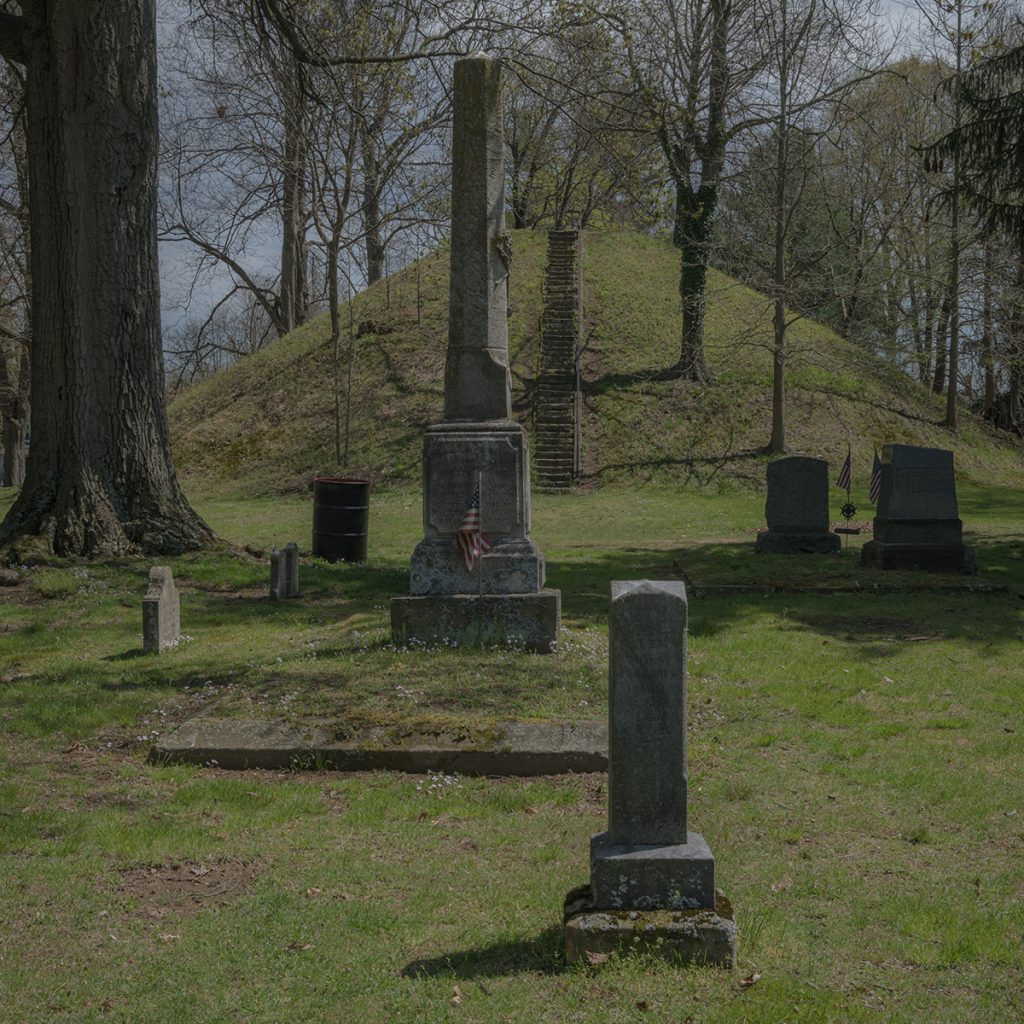
Rich-Joseph Facun | Little Cities | 2022
May 26, 2023Rich-Joseph Facun | Little Cities | 2022
…it takes an ocean of trust in the kingdom of rust…
(Doves)
The Cuyahoga River won’t kill you no more.
They cleaned it up back in ’74.
Well, you might get sick – but welcome to Ohio.
(Luke Doucet)
As I get older, there are some memories that still have an unexpected vivacity : and living again in the city and region where I grew up offers an odd looping of recollection, with elements of nostalgia – and the opposite of that, which might be cynicism or nihilism – informing and deforming my thoughts.
When I first encountered Rich – Joseph Facun’s images – specifically his Little Cities series – I felt transported back to my late teens and early twenties and shuttling back and forth between Windsor / Detroit and St. Catharines, seeing the underbelly of the rust belt wonderland. Specifically taking the train, and thus getting glimpses of smaller urban spaces across Southern Ontario that are often unseen or unconsidered, simply spaces to traverse on the way to somewhere else, not ‘valid’ to be ‘seen’ but as a space to be left behind or to be traversed with your mind – and destination elsewhere.
Facun’s scenes are part of a story that unfolds amidst the post-industrial United States – and these are spaces I’m familiar with from Niagara or the Windsor / Detroit region, that might be a ‘kingdom of rust’ or the ‘rust belt wonderland’ : a detritus of past ‘progress’, leavings of history that we might ignore or not acknowledge but that are literally part of the [memory of] landscape.
In Little Cities Rich-Joseph Facun “guides viewers on a meandering meditation through Southeastern Ohio by depicting the vernacular post-industrial landscape. In their quiet formality, the images call to mind past dreams, present disillusionment, and gently nudge us to look beyond what can be seen on the surface. Through recurring motifs, Facun excavates remaining signs of the Indigenous communities who once called this region home. In mankind’s hubris, we want to believe we shape the land we live on. Facun’s photographs remind us that the landscape contains memory, and it is witness to our misdeeds.” (from here)
Rich-Joseph Facun is a photographer of Indigenous Mexican and Filipino descent. His words : “His work aims to offer an authentic look into endangered, bygone, and fringe cultures—those transitions in time where places fade but people persist.
The exploration of place, community and cultural identity present themselves as a common denominator in both his life and photographic endeavors.
Before finding “home” in the Appalachian Foothills of southeast Ohio, Facun roamed the globe for 15 years working as a photojournalist. During that time he was sent on assignment to over a dozen countries, and for three of those years he was based in the United Arab Emirates.”
More of Facun’s work can be seen here and his IG is here. He has produced a publication for Little Cities, and I encourage you to spend some time with his Black Diamonds and 1804 series. Facun reminds me of Mary Ellen Mark‘s assertion as to how “photography is closest to writing, not painting. It’s closest to writing because you are using this machine to convey an idea. The image shouldn’t need a caption; it should already convey an idea.”
~ Bart Gazzola
Read More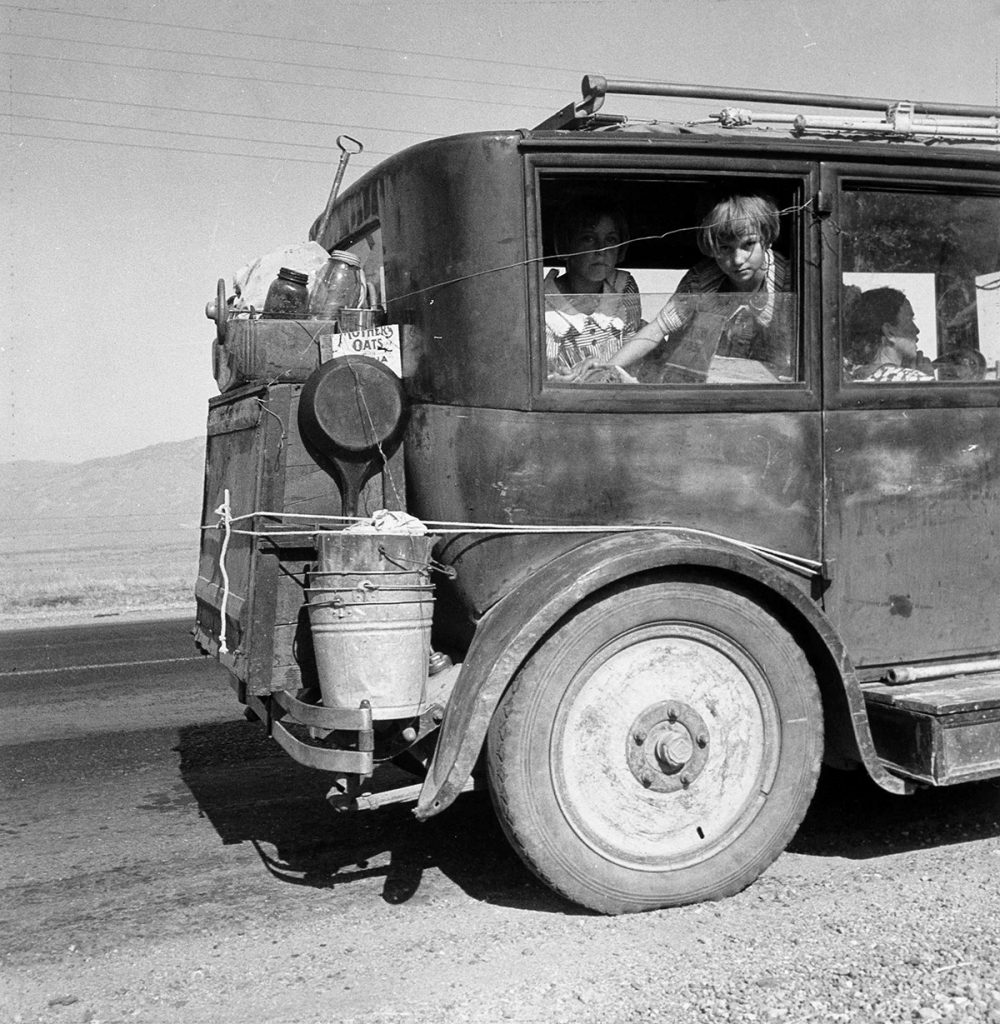
Dorothea Lange | A family of drought refugees from Abilene, Texas, on the road in California | 1936
May 4, 2023Dorothea Lange (1895 – 1965) | A family of drought refugees from Abilene, Texas, on the road in California | 1936
“The depression was making people disappear.
They vanished from factories and warehouses and workshops, the number of toilers halving, then halving again, until finally all were gone, the doors closed and padlocked, the buildings like tombs. They vanished from the lunchtime spots where they used to congregate, the diners and deli counters where they would grab coffee on the way in or a slice of pie on the way out.
They disappeared from the streets.
They were whisked from the apartments whose rents they couldn’t meet and carted out of the homes whose mortgages they couldn’t keep pace with, lending once thriving neighborhoods a desolate air, broken windows on porches and trash strewn across overgrown yards. They disappeared from the buses and streetcars, choosing to wear out their shoe leather rather than drop another dime down the driver’s metal bucket. They disappeared from shops and markets, because if you yourself could spend a few hours to build it, sew it, repair it, reline it, reshod it, reclod it, or reinvent it for some other purpose, you sure as hell weren’t going to buy a new one.
They disappeared from bedrooms, seeking solace where they could: a speakeasy, or, once the mistake of Prohibition had been corrected, a reopened tavern, or another woman’s arms—someone who might not have known their name and certainly didn’t know their faults well enough to judge them, someone who needed a laugh as badly as they did.
They disappeared, but never before your eyes; they never had that magic. It was like a shadow when the sun has set; you don’t notice the shadow’s absence because you expect it. But the next morning the sun rises, and the shadow’s still gone.”
(Thomas Mullen, The Many Deaths of the Firefly Brothers)
I have a tendency in my research to fall down rabbit holes: this is often shaped by history (my interest – which has manifested on this site – in post Soviet artists, for example) and of late The Great Depression has been a point of interest. My enjoyment of horror intersects here, so I will confess that I came to the author that I quote liberally above (whose book follows two brothers whom are bank robbers during the Great Depression, harshly factual and researched, but they find they are resurrected each time they’re killed in one of their robberies) through Daniel Knauf’s Carnivàle series. But, like another writer has pointed out, improbability and violence overflow from ordinary life, and the Great Depression was a time more, perhaps, malleable than most, as many assumptions were fractured irreparably…
And the horrors experienced by many from the Crash of 1929 through the Depression were ‘unimaginable’ to many, until they became commonplace, and now, it seems, have been forgotten. This is similar to how we forget that Lange’s subjects are not just icons but actual people who lived, suffered and died.
To many, Lange’s work requires no introduction. Many of her photographs are so stitched into the fabric of a communal history that they act as signifiers for collective memories. Nonetheless: Dorothea Lange “was an American documentary photographer and photojournalist, best known for her Depression-era work for the Farm Security Administration (FSA). Lange’s photographs influenced the development of documentary photography and humanized the consequences of the Great Depression.” (from here)
I return to Mullen’s book that had flavours of horror, but not in the way I expected, as it was more historical than ‘supernatural’ horror:
“Ten feet behind them, standing at the base of an arc light and looking in the opposite direction, was a young, balding man who Weston supposed was the father. The man looked as if he were trying very hard to become invisible.
When you bump into an old acquaintance on the street, you ask him how he’s doing. He tells you a story and then you tell him your story, and both of you are trying to see where you fit within the other’s. Your story says: This is the way the world is, and I’m the center, over here. But if the other guy tells a different story, with the world like this, where the center’s actually over here, then you realize that you’re way off to the side.
This man did not need to be told he was off to the side. He clearly realized it.”
More of Lange’s work – both her iconic images of The Great Depression and her later work that was more local but considered the same issues of justice and equality – can be seen here.
~ Bart Gazzola
Read More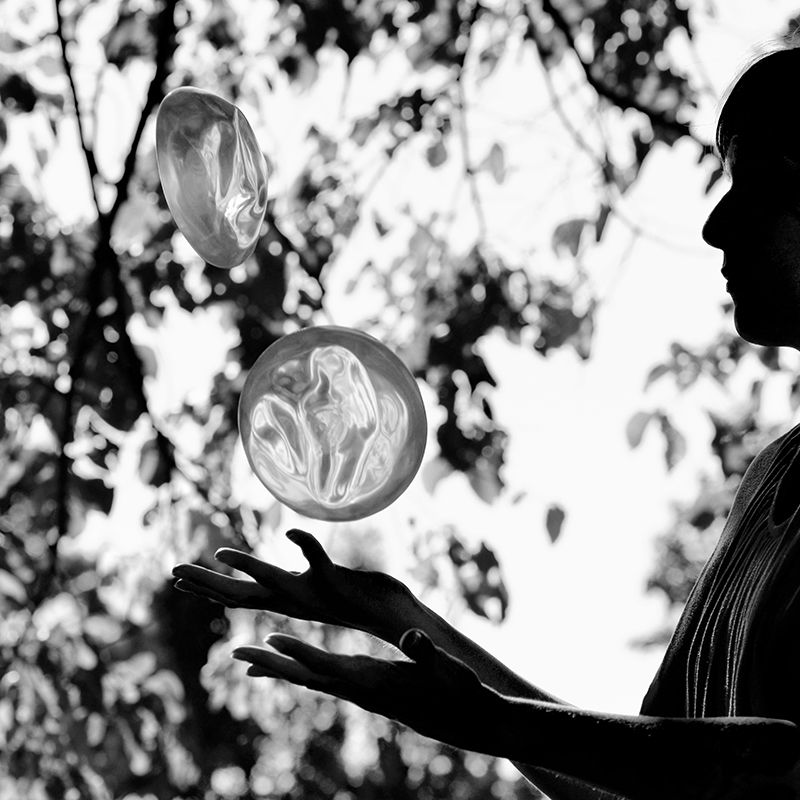
Lana | Transformations by Ruth Dick
June 1, 2022Lana | Transformations Photos by Ruth Dick Lana Series, Before, Image 3 - Photo by Ruth Dick LANA | TRANSFORMATIONS Photos... Read More
Recent Comments